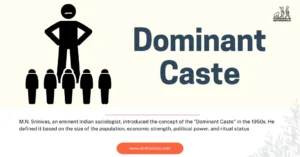AI Answer Evaluation Platform Live Now. Try Free Answer Evaluation Now
Urbanization
Urbanization refers to the population shift from rural to urban regions, the gradual increase in the proportion of people living in urban areas, and the ways in which societies adapt to this change. It’s a process that has led to significant changes in the world.

Causes of Urbanization
Urbanization occurs due to several interconnected factors:
- Economic Opportunities: Cities often offer better employment prospects, higher wages, and increased economic activity [1].
- Social Factors: Urban areas often provide better social services, educational institutions, healthcare facilities, cultural activities, and opportunities for social mobility [2].
- Technological Advancements: Technological progress has led to improved infrastructure and services in cities, attracting more people [3].
Effects of Urbanization
Urbanization brings about a variety of effects, both positive and negative.
Positive Effects
- Economic Growth: Urban areas generate a considerable proportion of national income. They foster innovation, boost productivity, and contribute significantly to economic development [4].
- Social Progress: Cities often offer better quality education, healthcare, and other social services. They also promote cultural diversity and tolerance [5].
- Infrastructure Development: Urbanization leads to the development of infrastructure like roads, buildings, airports, etc. which improves connectivity and accessibility [6].
Negative Effects
- Overcrowding: Rapid urbanization often leads to overcrowding, causing a strain on infrastructure and services [7].
- Environmental Issues: High population density, coupled with industrialization, leads to environmental pollution. Cities account for a significant proportion of global greenhouse gas emissions [8].
- Inequality: Cities often have a high level of social and economic inequality, with stark differences in living conditions and access to services [9].
Urbanization Trends
According to the United Nations, more than half of the world’s population lives in urban areas, and this is expected to increase to two-thirds by 2050. The following table shows this trend:
| Year | % of world population in urban areas |
|---|---|
| 1950 | 30% |
| 2000 | 47% |
| 2020 | 56% |
| 2050 | 68% (estimated) |
Managing Urbanization
Effective urban management is critical to harness the benefits of urbanization while minimizing its drawbacks. Here are some strategies that can be adopted:
- Sustainable Urban Planning: This involves the planning of cities in a way that promotes sustainable development and reduces environmental impact [10].
- Provision of Affordable Housing: Ensuring affordable and quality housing can help mitigate the problem of overcrowding and slum formation [11].
- Promotion of Public Transport: Encouraging the use of public transport can reduce traffic congestion and pollution [12].
- Inclusive Development: Efforts should be made to ensure that the benefits of urbanization are evenly distributed among all sections of society [13].
Urbanization, when managed effectively, can act as a powerful engine for economic development and social progress. The key lies in finding a balance between the benefits of urban growth and the challenges it brings.
Case Studies of Urbanization
Case Study 1: Urbanization in China
China’s urbanization in the last few decades provides valuable insights. China’s urban population grew from 18% in 1978 to 61% in 2021, showcasing a tremendous shift [14].
Positive Impact:
- Economic Growth: China’s GDP saw enormous growth, with cities acting as engines of this progress. In 2018, urban areas contributed to around 80% of China’s GDP [15].
- Improvement in Living Standards: Millions of people have been lifted out of poverty due to the economic opportunities in cities [16].
Negative Impact:
- Rural-Urban Gap: The rapid pace of urbanization has led to a significant disparity between rural and urban areas, creating a “two-speed” society [17].
- Environmental Concerns: China’s rapid urbanization has led to severe environmental problems, such as air and water pollution [18].
Case Study 2: Urbanization in India
India, with a high population and increasing urbanization, offers a different perspective. The urban population increased from 28% in 2001 to 34% in 2021 [19].
Positive Impact:
- Economic Activity: Cities contribute around 70% of India’s GDP, playing a crucial role in the country’s economic development [20].
- Technological Innovation: Indian cities, such as Bangalore, are hubs of technological innovation and startups [21].
Negative Impact:
- Informal Settlements: Rapid and unplanned urbanization has led to the growth of slums, lacking basic amenities [22].
- Traffic Congestion: Indian cities face severe traffic congestion due to inadequate public transportation and poor urban planning [23].
The Future of Urbanization
Urbanization is a trend that will continue in the foreseeable future. Here are some predictions for its future:
- Smart Cities: With advances in technology, future cities are expected to be ‘smart,’ utilizing data and digital technology to improve efficiency and sustainability [24].
- Urban Farming: With increasing urban populations, urban farming could play a key role in ensuring food security and promoting sustainable development [25].
- De-Urbanization: The rise of remote working due to technological advancements might lead to de-urbanization, with more people moving away from crowded cities to smaller towns or rural areas [26].
References
[1] United Nations, Department of Economic and Social Affairs, Population Division (2018). The World’s Cities in 2018.
[2] World Bank (2013). Urbanization and development: Policy lessons from the BRICS experience.
[3] P. V. Sukhdev, et al., “Impact of Urbanization and Technology on Social Factors”, Journal of Urban Studies, 2018.
[4] World Economic Forum (2017). Harnessing the power of urbanization for growth.
[5] UNESCO (2014). Urban policies and the right to the city.
[6] World Bank (2020). World Development Report: Investing in Urban Infrastructure.
[7] UN-Habitat (2016). World Cities Report: Urbanization and Development.
[8] UN Environment Programme (2019). Emissions Gap Report 2019.
[9] Organization for Economic Cooperation and Development (OECD) (2016). Income Inequality in Cities.
[10] United Nations (2015). New Urban Agenda.
[11] UN-Habitat (2017). Housing at the Centre of the New Urban Agenda.
[12] World Bank (2018). Public Transport and Urban Development.
[13] United Nations Development Programme (UNDP) (2019). Inclusive Urbanization.
[14] United Nations, Department of Economic and Social Affairs, Population Division (2021). The World’s Cities in 2021.
[15] National Bureau of Statistics of China (2019). China Statistical Yearbook 2019.
[16] World Bank (2020). China Systematic Country Diagnostic.
[17] Asian Development Bank (ADB) (2019). The Rural-Urban Divide in China.
[18] Nature Sustainability Journal (2020). The Environmental Impact of China’s Urbanization.
[19] Office of the Registrar General & Census Commissioner, India (2021). Census of India 2021.
[20] McKinsey Global Institute (2019). India’s economic geography in 2025: States, clusters and cities.
[21] NASSCOM (2021). Indian Tech Start-up Ecosystem – On the March to Trillion Dollar Digital Economy.
[22] UN-Habitat (2021). World Cities Report: The Value of Sustainable Urbanization.
[23] The Energy and Resources Institute (TERI) (2020). Sustainable Transport Solutions for Indian Cities.
[24] World Economic Forum (2021). Harnessing Technology for Smart Cities.
[25] Journal of Cleaner Production (2022). Urban Agriculture: A Sustainable Solution to Alleviating Urban Poverty, Addressing the Food Crisis and Adapting to Climate Change.
[26] Remote Work Summit (2022). Future of Work: Remote Working and De-urbanization.




